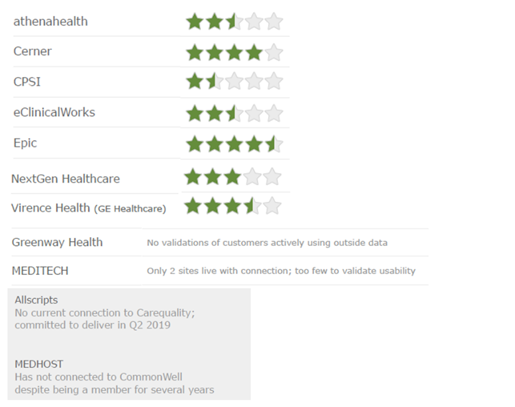
Interoperability: Shareable Data Versus Usable Data
KLAS’ interoperability reports over the past year have had a specific focus: the vendor connections to Carequality and CommonWell. Providers most frequently talk about these two networks allowing them to achieve “plug-and-play” interoperability without significant investments of time and money.
Last March, KLAS published a report on what EMR vendors had done to connect providers to Carequality or CommonWell. In December, we followed up with a report on the progress vendors had made over the previous six months. The third report and culminating data of this series published in February.
While 2018’s reports focused on whether providers were consuming data through the networks, the 2019 report focused on the EMR vendors’ ability to make that data usable by clinicians. Beyond connecting to Carequality and/or CommonWelll, vendors must make the incoming data easy to consume and part of the users’ workflow.
Vendor Progress
The good news is that most major EHR vendors are connected to Carequality and/or CommonWell. And because of the meaningful use mandate that problem, allergy, medication, and immunization (PAMI) data be discrete, all of those vendors can reconcile PAMI data.
There are significant differences in vendors’ abilities to handle labs and notes. On one end of the spectrum, providers have to manually select each patient; on the other end, data flows directly into the EMR without provider intervention. Most vendors are somewhere in the middle. Epic and Cerner are the most capable of bringing outside data into the clinician workflow.

The 2019 report digs into the nuances of each EMR vendor’s capabilities and even gives each vendor a rating on the overall usability of outside data:

To learn more about how outside data flows into your vendor’s EMR, you can read the full report.
No matter the EMR, there is room for improvement. For example, customers from every base complain about receiving redundant data. But the gap between shared data and usable data is narrower than many providers assume, and that gap continues to shrink.
The Next Hurdle
The technical capabilities are there. The biggest remaining hurdle is widespread adoption. Most vendors are having customers choose to do this one at a time.
Epic’s and athenahealth’s customer bases are, by and large, connected to the national networks and using outside data gleaned via those networks. Unfortunately, those vendors are the exceptions. Most vendors have less than 30% of their customers connected to one of the networks. Until there is widespread adoption, there will always be gaps in the clinical picture.
Another side effect from the lack of adoption is that it slows down the learning curve that providers must go through to become comfortable with the data. Many newly connected providers talk about concerns around implications of using outside data and how to use the outside data that is now available to them.
Epic’s customer base has the longest history of sharing plug-and-play data with other Epic organizations, starting first with Care Everywhere. Early on, their customers had many of the same concerns plaguing other providers now. Today, Epic customers have progressed to the point of being highly comfortable with using outside data. They are willing to let data flow directly into the native fields of the EMR.
There is certainly a learning curve associated with connecting to and using Carequality, CommonWell, and other organizations’ patient information. But I think healthcare stakeholders are pleased with the progress that EHR vendors are making in interoperability. It’s time for widespread adoption to remove the last remaining hurdles.
Hope for the Future
Despite the many challenges in the industry, today is an exciting time to be a healthcare provider. Plug-and-play interoperability is finally within our grasp.
There are a lot of other pieces of interoperability that still need to be explored, but the industry has a lot of forward momentum. I am hopeful that over the next few years, the belief that exchanging patient data doesn’t work will fade away.
Photo Cred: Shutterstock, Profit_Image